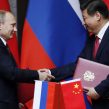
Missile Defense in East Asia and New Trends in the Russo-Chinese Partnership
Publication: Eurasia Daily Monitor Volume: 13 Issue: 52
By:

The Russo-Chinese partnership, if not alliance, has frequently encountered challenges and obstacles in the past. Two years ago, Russian Defense Minister Segei Shoigu and his deputy, Anatoly Antonov, openly called for a military alliance against terrorism and color revolutions, although for now, China has remained silent on the matter (Ministry of Defense of the Russian Federation, November 18, 2014; Nezavisimaya Gazeta, November 20, 2014). And in their recent book, Russia’s Far East: New Dynamics in Asia Pacific and Beyond (Lynne Rienner Publishers, 2015), Artem Lukin and Rensselaer Lee flatly say that President Vladimir Putin has sought an alliance with Beijing since 2014.
But as many Russian and Western writers have observed, Chinese support for Russia has turned out to be considerably less than expected. This has been especially true in the economic sphere, which became particularly important for Moscow following its isolation by the West—prompted by Russia’s annexation of Crimea and war in eastern Ukraine. Chinese caution about violating the United States’ and the European Union’s sanctions and running afoul of US banking rules, concerns about investing in Russia, and China’s own economic crisis have all contributed to this earlier limited Chinese exposure to the Russian economy. Not surprisingly, this led to a lot of grumbling in Russia about the actual value of the supposed alliance with China (Carnegie.ru, September 29, 2015).
Nonetheless, recent developments have apparently alerted China to the costs of not doing more to nurture this budding alliance. The government in Beijing has even issued a statement saying it is full of confidence in the development “prospect” of what both sides call the “comprehensive strategic partnership” between them (China Daily, March 14). The fact that such statements have to be issued suggests that, in fact, China has serious doubts about Russian economic development. Thus, Beijing has now loaned Gazprom $2.17 billion and is increasing its stake in a $27 billion liquefied natural gas (LNG) project in the Arctic. China is also helping keep Rosneft afloat with prepayments for pledged oil supplies worth $35 billion (China Business News, January 27). At the same time Russia and China are also launching a new railway route for container shipments (Sputnik News, February 27). While all this supposedly shows that Russian firms can raise money, in actuality it solidifies Chinese influence over Russia’s energy behemoths while showing critics that China does deliver for its friend (RT, Wall Street Journal, March 3).
Besides economic necessities, the two sides are also increasingly being drawn together by events in Syria and North Korea. In Syria, they can see Russia’s gains and contrast those with the US’s confusion about how to deal with the military and political situation on the ground. And while Washington futilely seeks a way out of the conflict, Moscow and Beijing are eager to expand their presence and influence there—Russia’s recently announced partial military drawdown, notwithstanding (see EDM, March 15). In North Korea, things are more urgent for them. Both countries have strongly criticized Pyongyang’s nuclear and missile tests. But in their shared view, the US’s alleged threats against North Korea are what is actually driving Pyongyang to this behavior. And China and Russia claim that the United States has used the opportunity presented by the belligerent North Korean behavior to inveigle South Korea into accepting the THAAD missile defense system that Moscow and Beijing both oppose. Both sides have strongly spoken out against the deployment of THAAD in East Asia, claiming that Washington is overreacting and using alleged North Korean bad behavior as a pretext. Rather, these two Asian powers claim that they will do more to bring North Korea to the table without any preconditions (People’s Daily, Xinhua, March 13; Sputnik.com, February 2, March 13).
In their foreign minister’s meeting on March 11, not only did both sides review and reaffirm their common positions on Syria, North Korea, Afghanistan and the 5+1 agreement on Iran, but they also agreed to strengthen bilateral coordination on foreign policy. Apparently, the two sides have agreed to approximately 50 rounds of consultations between them, in the near future, at the deputy minister and head of department levels. According to both foreign ministers, this is the most comprehensive document of its kind that Russia has with any of its partners, and it reflects China’s desire to keep Russia on board by tightening inter-governmental coordination on global issues—just as Moscow has clearly wished (Mid.ru, March 11).
While the above-mentioned moves—particularly those in the economic sphere—reflect the unspoken but nonetheless discernible stresses in the Russian-Chinese relationship, the overwhelming thrust is toward ever grater partnership. Russian dependence on China will grow due to Moscow’s ongoing refusal to reform its economy combined with the factors of low energy prices and sanctions, not to mention ongoing Western hostility toward Russian ambitions. Whereas China, which is itself facing serous tensions with the US and profound economic challenges at home, likewise is loath to disillusion Russia to the gains it could expect from their partnership. Therefore the all-too-prevalent idea that there is not much to be concerned about with regard to this partnership, is quite misconceived. One need only examine the facts on the ground in East Asia thanks to Russian arms sales, China’s growing engagement with Russia in the Middle East, and Beijing’s growing preeminence in Central Asia to see that the identity of interests between them does not promise stability either to Europe or to Asia—let alone to the US.




